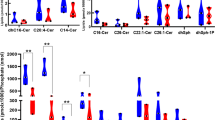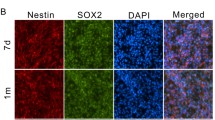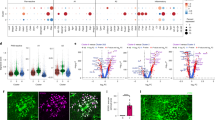Abstract
Ependymal cells (ECs) line the ventricular surfaces of the mammalian central nervous system (CNS) and their development is indispensable to structural integrity and functions of the CNS. We previously reported that EC-specific genetic deletion of the myristoylated alanine-rich protein kinase C substrate (Marcks) disrupts barrier functions and elevates oxidative stress and lipid droplet accumulation in ECs causing precocious cellular aging. However, little is known regarding the mechanisms that mediate these changes in ECs. To gain insight into Marcks-mediated mechanisms, we performed mass spectrometric analyses on Marcks-associated proteins in young and aged ECs in the mouse forebrain using an integrated approach. Network analysis on annotated proteins revealed that the identified Marcks-associated complexes are in part involved in protein transport mechanisms in young ECs. In fact, we found perturbed intracellular vesicular trafficking in cultured ECs with selective deletion of Marcks (Marcks-cKO mice), or upon pharmacological alteration to phosphorylation status of Marcks. In comparison, Marcks-associated protein complexes in aged ECs appear to be involved in regulation of lipid metabolism and responses to oxidative stress. Confirming this, we found elevated signatures of inflammation in the cerebral cortices and the hippocampi of young Marcks-cKO mice. Interestingly, behavioral testing using a water maze task indicated that spatial learning and memory is diminished in young Marcks-cKO mice similar to aged wildtype mice. Taken together, our study provides first line of evidence for potential mechanisms that may mediate differential Marcks functions in young and old ECs, and their effect on forebrain homeostasis during aging.







Similar content being viewed by others
Data availability
Proteomics data that support the findings of this study are openly available in PanoramaWeb at https://panoramaweb.org, reference number 20210423. Additional data that support the findings of this study are available from the corresponding author upon request.
References
Jacquet BV, Salinas-Mondragon R, Liang H, Therit B, Buie JD, Dykstra M, Campbell K, Ostrowski LE, Brody SL, Ghashghaei HT. FoxJ1-dependent gene expression is required for differentiation of radial glia into ependymal cells and a subset of astrocytes in the postnatal brain. Development. 2009;136:4021–31.
Paez-Gonzalez P, Abdi K, Luciano D, Liu Y, Soriano-Navarro M, Rawlins E, Bennett V, Garcia-Verdugo JM, Kuo CT. Ank3-dependent SVZ niche assembly is required for the continued production of new neurons. Neuron. 2011;71:61–75.
Spassky N, Merkle FT, Flames N, Tramontin AD, García-Verdugo JM, Alvarez-Buylla A. Adult ependymal cells are postmitotic and are derived from radial glial cells during embryogenesis. J Neurosci. 2005;25:10–8.
Brody SL, Yan XH, Wuerffel MK, Song SK, Shapiro SD. Ciliogenesis and left-right axis defects in forkhead factor HFH-4-null mice. Am J Respir Cell Mol Biol. 2000;23:45–51.
Del Bigio MR. Ependymal cells: biology and pathology. Acta Neuropathol. 2010;119:55–73.
Del Bigio MR. The ependyma: a protective barrier between brain and cerebrospinal fluid. Glia. 1995;14:1–13.
Fame RM, Lehtinen MK. Emergence and Developmental Roles of the Cerebrospinal Fluid System. Dev Cell. 2020;52:261–75.
Jiménez AJ, Domínguez-Pinos M-D, Guerra MM, Fernández-Llebrez P & Pérez-Fígares J-M (2014) Structure and function of the ependymal barrier and diseases associated with ependyma disruption. Tissue Barriers 2. Available at: https://www.ncbi.nlm.nih.gov/pmc/articles/PMC4091052/ [Accessed March 30, 2021].
Johanson C, Stopa E, McMillan P, Roth D, Funk J, Krinke G. The distributional nexus of choroid plexus to cerebrospinal fluid, ependyma and brain: toxicologic/pathologic phenomena, periventricular destabilization, and lesion spread. Toxicol Pathol. 2011;39:186–212.
Jacquet BV, Muthusamy N, Sommerville LJ, Xiao G, Liang H, Zhang Y, Holtzman MJ, Ghashghaei HT. Specification of a Foxj1-dependent lineage in the forebrain is required for embryonic-to-postnatal transition of neurogenesis in the olfactory bulb. J Neurosci. 2011;31:9368–82.
Lim DA, Tramontin AD, Trevejo JM, Herrera DG, García-Verdugo JM, Alvarez-Buylla A. Noggin antagonizes BMP signaling to create a niche for adult neurogenesis. Neuron. 2000;28:713–26.
Muthusamy N, Sommerville LJ, Moeser AJ, Stumpo DJ, Sannes P, Adler K, Blackshear PJ, Weimer JM, Ghashghaei HT. MARCKS-dependent mucin clearance and lipid metabolism in ependymal cells are required for maintenance of forebrain homeostasis during aging. Aging Cell. 2015;14:764–73.
Shook BA, Lennington JB, Acabchuk RL, Halling M, Sun Y, Peters J, Wu Q, Mahajan A, Fellows DW, Conover JC. Ventriculomegaly associated with ependymal gliosis and declines in barrier integrity in the aging human and mouse brain. Aging Cell. 2014;13:340–50.
Spassky N, Meunier A. The development and functions of multiciliated epithelia. Nat Rev Mol Cell Biol. 2017;18:423–36.
Palha JA, Santos NC, Marques F, Sousa J, Bessa J, Miguelote R, Sousa N, Belmonte-de-Abreu P. Do genes and environment meet to regulate cerebrospinal fluid dynamics? Relevance for schizophrenia Front Cell Neurosci. 2012;6:31.
Todd KL, Brighton T, Norton ES, Schick S, Elkins W, Pletnikova O, Fortinsky RH, Troncoso JC, Molfese PJ, Resnick SM, Conover JC & Initiative for the ADN (2018) Ventricular and periventricular anomalies in the aging and cognitively impaired brain. Front. Aging Neurosci. 9. Available at: https://www.frontiersin.org/articles/https://doi.org/10.3389/fnagi.2017.00445/full [Accessed March 30, 2021].
Wallmeier J, Frank D, Shoemark A, Nöthe-Menchen T, Cindric S, Olbrich H, Loges NT, Aprea I, Dougherty GW, Pennekamp P, Kaiser T, Mitchison HM, Hogg C, Carr SB, Zariwala MA, Ferkol T, Leigh MW, Davis SD, Atkinson J, Dutcher SK, Knowles MR, Thiele H, Altmüller J, Krenz H, Wöste M, Brentrup A, Ahrens F, Vogelberg C, Morris-Rosendahl DJ, Omran H. De novo mutations in FOXJ1 result in a motile ciliopathy with hydrocephalus and randomization of left/right body asymmetry. Am J Hum Genet. 2019;105:1030–9.
Park J-A, Crews AL, Lampe WR, Fang S, Park J, Adler KB. Protein kinase C delta regulates airway mucin secretion via phosphorylation of MARCKS protein. Am J Pathol. 2007;171:1822–30.
Hartwig JH, Thelen M, Rosen A, Janmey PA, Nairn AC, Aderem A. MARCKS is an actin filament crosslinking protein regulated by protein kinase C and calcium-calmodulin. Nature. 1992;356:618–22.
Aderem A. Signal transduction and the actin cytoskeleton: the roles of MARCKS and profilin. Trends Biochem Sci. 1992;17:438–43.
Rohrbach TD, Shah N, Jackson WP, Feeney EV, Scanlon S, Gish R, Khodadadi R, Hyde SO, Hicks PH, Anderson JC, Jarboe JS, Willey CD. The effector domain of MARCKS is a nuclear localization signal that regulates cellular PIP2 levels and nuclear PIP2 localization. PLoS One. 2015;10:e0140870.
Taniguchi H, Manenti S. Interaction of myristoylated alanine-rich protein kinase C substrate (MARCKS) with membrane phospholipids. J Biol Chem. 1993;268:9960–3.
Eckert RE, Neuder LE, Park J, Adler KB, Jones SL. Myristoylated alanine-rich C-kinase substrate (MARCKS) protein regulation of human neutrophil migration. Am J Respir Cell Mol Biol. 2010;42:586–94.
Green TD, Park J, Yin Q, Fang S, Crews AL, Jones SL, Adler KB. Directed migration of mouse macrophages in vitro involves myristoylated alanine-rich C-kinase substrate (MARCKS) protein. J Leukoc Biol. 2012;92:633–9.
Ott LE, Sung EJ, Melvin AT, Sheats MK, Haugh JM, Adler KB, Jones SL. Fibroblast migration is regulated by myristoylated alanine-rich C-Kinase substrate (MARCKS) protein. PLoS One. 2013;8:e66512.
Aparicio G, Arruti C, Zolessi FR. MARCKS phosphorylation by PKC strongly impairs cell polarity in the chick neural plate. Genesis. 2018;56:e23104.
Disatnik M-H, Boutet SC, Lee CH, Mochly-Rosen D, Rando TA. Sequential activation of individual PKC isozymes in integrin-mediated muscle cell spreading: a role for MARCKS in an integrin signaling pathway. J Cell Sci. 2002;115:2151–63.
Disatnik M-H, Boutet SC, Pacio W, Chan AY, Ross LB, Lee CH, Rando TA. The bi-directional translocation of MARCKS between membrane and cytosol regulates integrin-mediated muscle cell spreading. J Cell Sci. 2004;117:4469–79.
Fang S, Crews AL, Chen W, Park J, Yin Q, Ren X-R, Adler KB. MARCKS and HSP70 interactions regulate mucin secretion by human airway epithelial cells in vitro. Am J Physiol Lung Cell Mol Physiol. 2013;304:L511-518.
Yang H, Wang X, Sumners C, Raizada MK. Obligatory role of protein kinase Cbeta and MARCKS in vesicular trafficking in living neurons. Hypertension. 2002;39:567–72.
Brudvig JJ, Weimer JM. X MARCKS the spot: myristoylated alanine-rich C kinase substrate in neuronal function and disease. Front Cell Neurosci. 2015;9:407.
Sheats MK, Yin Q, Fang S, Park J, Crews AL, Parikh I, Dickson B, Adler KB. MARCKS and Lung Disease. Am J Respir Cell Mol Biol. 2018;60:16–27.
Stumpo DJ, Bock CB, Tuttle JS, Blackshear PJ. MARCKS deficiency in mice leads to abnormal brain development and perinatal death. Proc Natl Acad Sci U S A. 1995;92:944–8.
Weimer JM, Yokota Y, Stanco A, Stumpo DJ, Blackshear PJ, Anton ES. MARCKS modulates radial progenitor placement, proliferation and organization in the developing cerebral cortex. Development. 2009;136:2965–75.
Bailey KL, LeVan TD, Yanov DA, Pavlik JA, DeVasure JM, Sisson JH, Wyatt TA. Non-typeable Haemophilus influenzae decreases cilia beating via protein kinase Cε. Respir Res. 2012;13:49.
Wyatt TA, Sisson JH, Allen-Gipson DS, McCaskill ML, Boten JA, DeVasure JM, Bailey KL, Poole JA. Co-exposure to cigarette smoke and alcohol decreases airway epithelial cell cilia beating in a protein kinase Cε-dependent manner. Am J Pathol. 2012;181:431–40.
Lein ES, Hawrylycz MJ, Ao N, Ayres M, Bensinger A, Bernard A, Boe AF, Boguski MS, Brockway KS, Byrnes EJ, Chen L, Chen L, Chen T-M, Chin MC, Chong J, Crook BE, Czaplinska A, Dang CN, Datta S, Dee NR, Desaki AL, Desta T, Diep E, Dolbeare TA, Donelan MJ, Dong H-W, Dougherty JG, Duncan BJ, Ebbert AJ, Eichele G, Estin LK, Faber C, Facer BA, Fields R, Fischer SR, Fliss TP, Frensley C, Gates SN, Glattfelder KJ, Halverson KR, Hart MR, Hohmann JG, Howell MP, Jeung DP, Johnson RA, Karr PT, Kawal R, Kidney JM, Knapik RH, Kuan CL, Lake JH, Laramee AR, Larsen KD, Lau C, Lemon TA, Liang AJ, Liu Y, Luong LT, Michaels J, Morgan JJ, Morgan RJ, Mortrud MT, Mosqueda NF, Ng LL, Ng R, Orta GJ, Overly CC, Pak TH, Parry SE, Pathak SD, Pearson OC, Puchalski RB, Riley ZL, Rockett HR, Rowland SA, Royall JJ, Ruiz MJ, Sarno NR, Schaffnit K, Shapovalova NV, Sivisay T, Slaughterbeck CR, Smith SC, Smith KA, Smith BI, Sodt AJ, Stewart NN, Stumpf K-R, Sunkin SM, Sutram M, Tam A, Teemer CD, Thaller C, Thompson CL, Varnam LR, Visel A, Whitlock RM, Wohnoutka PE, Wolkey CK, Wong VY, Wood M, Yaylaoglu MB, Young RC, Youngstrom BL, Yuan XF, Zhang B, Zwingman TA, Jones AR. Genome-wide atlas of gene expression in the adult mouse brain. Nature. 2007;445:168–76.
Szklarczyk D, Gable AL, Lyon D, Junge A, Wyder S, Huerta-Cepas J, Simonovic M, Doncheva NT, Morris JH, Bork P, Jensen LJ, von Mering C. STRING v11: protein-protein association networks with increased coverage, supporting functional discovery in genome-wide experimental datasets. Nucleic Acids Res. 2019;47:D607–13.
Huang DW, Sherman BT, Lempicki RA. Systematic and integrative analysis of large gene lists using DAVID bioinformatics resources. Nat Protoc. 2009;4:44–57.
Green TD, Crews AL, Park J, Fang S, Adler KB. Regulation of mucin secretion and inflammation in asthma: a role for MARCKS protein? Biochim Biophys Acta. 2011;1810:1110–3.
Lampe WR, Park J, Fang S, Crews AL, Adler KB. Calpain and MARCKS protein regulation of airway mucin secretion. Pulm Pharmacol Ther. 2012;25:427–31.
Leverkoehne I & Gruber AD (2016) The Murine mCLCA3 (Alias gob-5) Protein Is Located in the Mucin Granule Membranes of Intestinal, Respiratory, and Uterine Goblet Cells: Journal of Histochemistry & Cytochemistry. Available at: https://journals.sagepub.com/doi/https://doi.org/10.1177/002215540205000609 [Accessed December 11, 2019].
Park J, Fang S, Crews AL, Lin K-W, Adler KB. MARCKS regulation of mucin secretion by airway epithelium in vitro: interaction with chaperones. Am J Respir Cell Mol Biol. 2008;39:68–76.
Piirsoo M, Meijer D, Timmusk T. Expression analysis of the CLCA gene family in mouse and human with emphasis on the nervous system. BMC Dev Biol. 2009;9:10.
Rogers DF. The airway goblet cell. Int J Biochem Cell Biol. 2003;35:1–6.
Yang P, Xu C, Reece EA, Chen X, Zhong J, Zhan M, Stumpo DJ, Blackshear PJ, Yang P. Tip60- and sirtuin 2-regulated MARCKS acetylation and phosphorylation are required for diabetic embryopathy. Nat Commun. 2019;10:282.
Raman M, Sergeev M, Garnaas M, Lydeard JR, Huttlin EL, Goessling W, Shah JV, Harper JW. Systematic proteomics of the VCP-UBXD adaptor network identifies a role for UBXN10 in regulating ciliogenesis. Nat Cell Biol. 2015;17:1356–69.
Ibañez-Tallon I, Gorokhova S, Heintz N. Loss of function of axonemal dynein Mdnah5 causes primary ciliary dyskinesia and hydrocephalus. Hum Mol Genet. 2002;11:715–21.
Maiti AK, Mattéi MG, Jorissen M, Volz A, Zeigler A, Bouvagnet P. Identification, tissue specific expression, and chromosomal localisation of several human dynein heavy chain genes. Eur J Hum Genet. 2000;8:923–32.
Venugopal N, Ghosh A, Gala H, Aloysius A, Vyas N, Dhawan J. The primary cilium dampens proliferative signaling and represses a G2/M transcriptional network in quiescent myoblasts. BMC Molecular and Cell Biology. 2020;21:25.
Wu K, Tang F, Lee D, Zhao Y, Song H, Zhu X-J, Mei L & Xiong W-C (2020) Ependymal Vps35 promotes ependymal cell differentiation and survival, suppresses microglial activation, and prevents neonatal hydrocephalus. J. Neurosci. Available at: https://www.jneurosci.org/content/early/2020/04/07/JNEUROSCI.1520-19.2020 [Accessed April 1, 2021].
Dai J, Su Y, Zhong S, Cong L, Liu B, Yang J, Tao Y, He Z, Chen C, Jiang Y. Exosomes: key players in cancer and potential therapeutic strategy. Signal Transduct Target Ther. 2020;5:1–10.
Zhou L, Lv T, Zhang Q, Zhu Q, Zhan P, Zhu S, Zhang J, Song Y. The biology, function and clinical implications of exosomes in lung cancer. Cancer Lett. 2017;407:84–92.
Dooley K, McConnell RE, Xu K, Lewis ND, Haupt S, Youniss MR, Martin S, Sia CL, McCoy C, Moniz RJ, Burenkova O, Sanchez-Salazar J, Jang SC, Choi B, Harrison RA, Houde D, Burzyn D, Leng C, Kirwin K, Ross NL, Finn JD, Gaidukov L, Economides KD, Estes S, Thornton JE, Kulman JD, Sathyanarayanan S & Williams DE (2021) A versatile platform for generating engineered extracellular vesicles with defined therapeutic properties. Mol Ther.
Tamura R, Balabanova A, Frakes SA, Bargmann A, Grimm J, Koch TH, Yin H. Photoactivatable prodrug of doxazolidine targeting exosomes. J Med Chem. 2019;62:1959–70.
Frydrychowicz M, Kolecka-Bednarczyk A, Madejczyk M, Yasar S, Dworacki G. Exosomes – Structure, Biogenesis and Biological Role in Non-Small-Cell Lung Cancer. Scand J Immunol. 2015;81:2–10.
Káradóttir RT, Kuo CT. Neuronal activity-dependent control of postnatal neurogenesis and gliogenesis. Annu Rev Neurosci. 2018;41:139–61.
Biesmans S, Meert TF, Bouwknecht JA, Acton PD, Davoodi N, De Haes P, Kuijlaars J, Langlois X, Matthews LJR, Ver Donck L, Hellings N & Nuydens R (2013) Systemic immune activation leads to neuroinflammation and sickness behavior in mice. Mediators Inflamm 2013. Available at: https://www.ncbi.nlm.nih.gov/pmc/articles/PMC3723093/ [Accessed October 9, 2020].
Farfara D, Feierman E, Richards A, Revenko AS, MacLeod RA, Norris EH, Strickland S. Knockdown of circulating C1 inhibitor induces neurovascular impairment, glial cell activation, neuroinflammation, and behavioral deficits. Glia. 2019;67:1359–73.
Muthusamy N, Vijayakumar A, Cheng G, Ghashghaei HT. A knock-in Foxj1(CreERT2::GFP) mouse for recombination in epithelial cells with motile cilia. Genesis. 2014;52:350–8.
Benson S, Brinkhoff A, Lueg L, Roderigo T, Kribben A, Wilde B, Witzke O, Engler H, Schedlowski M, Elsenbruch S. Effects of acute systemic inflammation on the interplay between sad mood and affective cognition. Transl Psychiatry. 2017;7:1–10.
Haroon E, Raison CL, Miller AH. Psychoneuroimmunology meets neuropsychopharmacology: translational implications of the impact of inflammation on behavior. Neuropsychopharmacology. 2012;37:137–62.
Loziuk PL, Parker J, Li W, Lin C-Y, Wang JP, Li Q, Sederoff RR, Chiang VL, Muddiman DC. Elucidation of xylem-specific transcription factors and absolute quantification of enzymes regulating cellulose biosynthesis in Populus trichocarpa. J Proteome Res. 2015;14:4158–68.
Gokce E, Shuford CM, Franck WL, Dean RA, Muddiman DC. Evaluation of normalization methods on GeLC-MS/MS label-free spectral counting data to correct for variation during proteomic workflows. J Am Soc Mass Spectrom. 2011;22:2199–208.
Jacquet BV, Patel M, Iyengar M, Liang H, Therit B, Salinas-Mondragon R, Lai C, Olsen JC, Anton ES, Ghashghaei HT. Analysis of neuronal proliferation, migration and differentiation in the postnatal brain using equine infectious anemia virus-based lentiviral vectors. Gene Ther. 2009;16:1021–33.
Ostrowski LE, Hutchins JR, Zakel K, O’Neal WK. Targeting expression of a transgene to the airway surface epithelium using a ciliated cell-specific promoter. Mol Ther. 2003;8:637–45.
Jacquet BV, Ruckart P & Ghashghaei HT (2010) An organotypic slice assay for high-resolution time-lapse imaging of neuronal migration in the postnatal brain. J Vis Exp.
Vorhees CV, Williams MT. Morris water maze: procedures for assessing spatial and related forms of learning and memory. Nat Protoc. 2006;1:848–58.
Acknowledgements
This work is supported by NIH grant R01NS098370 to HTG. Drs. Laura Sommerville and Jennifer Parker provided technical support.
Funding
national institute of neurological disorders and stroke,R01NS098370,H. Troy Ghashghaei
Author information
Authors and Affiliations
Contributions
H.T.G. and N.M. conceived the project, analyzed data, and wrote the manuscript. N.M. performed experiments; T.I.W. and D.C.M. conducted mass spectrometry, nanoLC-MS/MS analysis, and helped edit the manuscript; J.J.B. and J.M.W. validated proteomic data and helped edited the manuscript; K.B.A provided reagents.
Corresponding author
Ethics declarations
Conflict of interest
KA holds 130,000 founders’ shares of a start-up biotech company, Biomarck, and serves as a scientific consultant without monetary compensation. KA receives over $100,000 yearly in research grants from the National Institutes of Health (NIH). The remaining authors have declared no competing interests.
Additional information
Publisher's Note
Springer Nature remains neutral with regard to jurisdictional claims in published maps and institutional affiliations.
Supplementary Information
Below is the link to the electronic supplementary material.
About this article
Cite this article
Muthusamy, N., Williams, T.I., O’Toole, R. et al. Phosphorylation-dependent proteome of Marcks in ependyma during aging and behavioral homeostasis in the mouse forebrain. GeroScience 44, 2077–2094 (2022). https://doi.org/10.1007/s11357-022-00517-3
Received:
Accepted:
Published:
Issue Date:
DOI: https://doi.org/10.1007/s11357-022-00517-3




